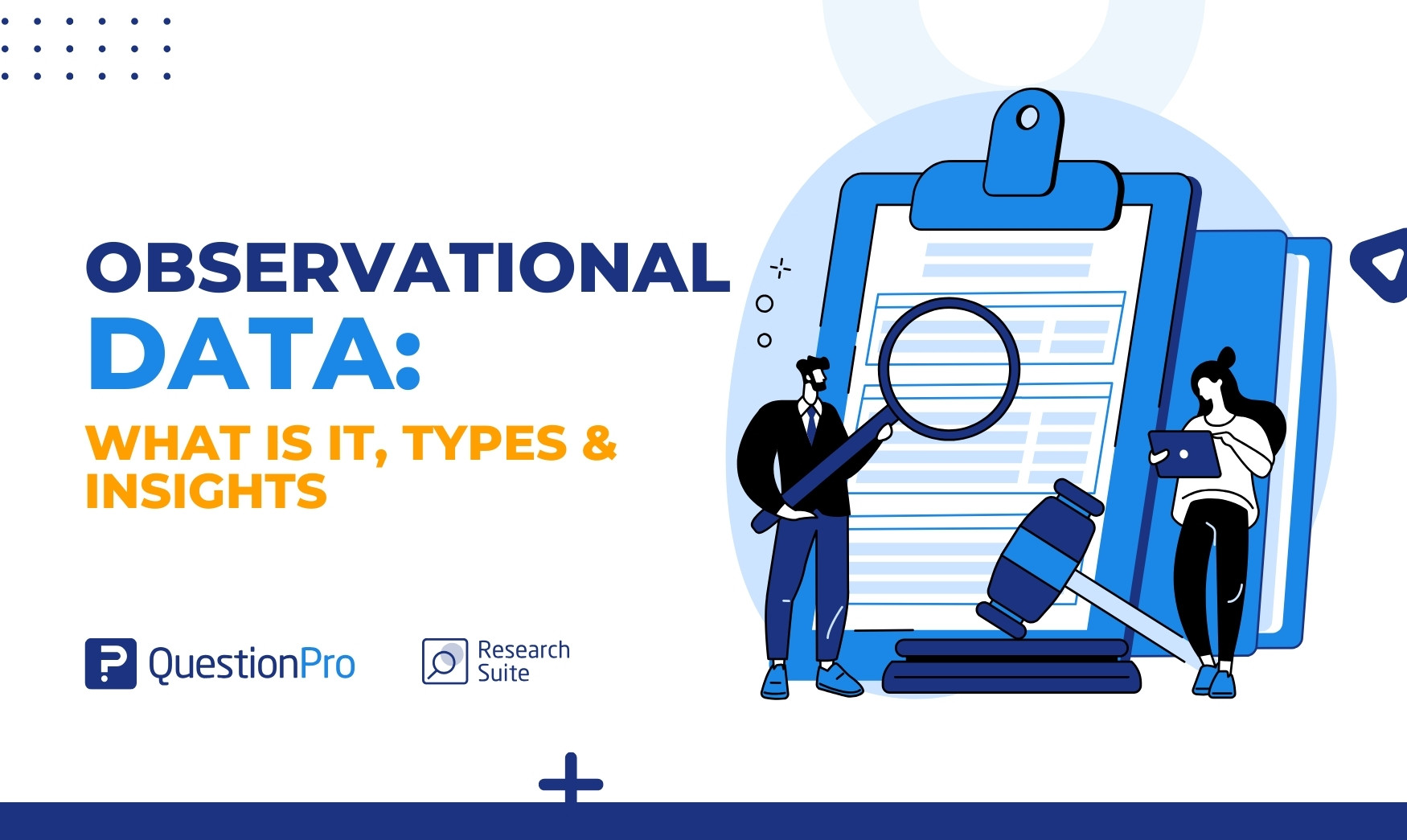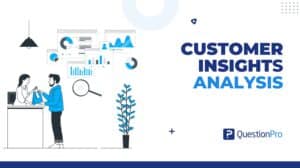
Data is the lifeblood of modern decision-making. From business analytics to scientific research, the collection and analysis of data are crucial in gaining valuable insights and making informed choices. One type of data that holds a unique place in this realm is observational data.
A controlled experiment involves gathering observational data under carefully regulated conditions to assess the impact of specific variables on the outcome. In this blog, we will explore what this data is, its various types, and the insights it can offer.
What is observational data?
Observational data, also known as observational study data, is collected by observing and recording events, behaviors, or phenomena as they naturally occur without interference or manipulation.
Researchers collect this data to gain real-time insights, make inferences, or test hypotheses. It often contrasts with experimental data analysis, where researchers manipulate background variables to study their effects.
A cohort study involves collecting long-term data on a group of individuals with similar characteristics, allowing researchers to analyze trends and outcomes over time.
Cohort studies have been instrumental in uncovering the long-term health effects of smoking by following groups of smokers and non-smokers over many years and analyzing observational data to identify patterns and risks associated with tobacco use.
Types of observational data
Observational data can be categorized into two main types: structured and unstructured.
1. Structured
In structured observations, researchers follow a predefined plan or protocol to record specific aspects of a phenomenon. This method is highly controlled and standardized, ensuring that all data points are collected uniformly.
Examples of structured observational data include checklists, surveys, and rating scales. This data type is often used in clinical practice fields like psychology, education, and social sciences to study human behavior and interactions.
2. Unstructured
Unstructured observations are more flexible and open-ended. Researchers follow a relaxed protocol but observe events and behaviors as they occur, often without predefined categories or criteria.
This type of data collection is commonly used in ethnographic studies, anthropology, and naturalistic observations in ecology and biology.
Insights of observational data
It can provide many insights, depending on the research questions and methods used. Here are some of the valuable insights that can be gained from data:
Understanding Human Behavior
It is crucial for understanding human behavior in various settings. It allows researchers to witness how people act in their natural environment, free from the influence of surveys or experiments.
Identifying Patterns and Trends
It can reveal patterns and trends that might not be apparent through other data collection methods. These patterns can be used for predictions or to inform decision-making.
Exploring Context
It provides a rich context for understanding events that can contain any risk factor. Researchers can better understand the circumstances and risk factors influencing the observed behaviors.
Quality Assurance
It is often used for quality assurance and process improvement in fields like healthcare and manufacturing. It helps identify issues and areas for improvement in real time.
Environmental Studies
Ecologists and environmental scientists use data to study ecosystems, wildlife behavior, and the impact of human activities on the environment.
Market Research
This data is valuable in market research, especially for tracking consumer behavior, preferences, and trends. It optimizes product placement, store layouts, and marketing strategies.
Safety and Security
It is used for monitoring and ensuring safety and security in various contexts, such as surveillance systems, traffic management, and public spaces.
Randomized Controlled Trial
The analysis of various research findings indicated that there was minimal supporting data to suggest substantial distinctions in the effects between observational studies and randomized controlled trials.
Techniques of gathering observational data
Collecting observational data is a valuable observational research method that can provide unique insights. There are various techniques for gathering data, depending on the nature of the study and the research goals.
Here are some standard techniques:
1. Direct Observation
This involves researchers physically observing the subject of study in its natural setting without interfering or influencing the observed behaviors. It is often used in fields such as psychology, anthropology, and ecology.
2. Participant Observation
In this technique, researchers actively engage in the environment or control group they are studying. They become participants in the observed context, allowing them to gain an insider’s perspective. This is common in ethnographic studies.
3. Structured Observation
Researchers use a predefined protocol or checklist to record specific behaviors or events. This approach ensures consistency and allows for easy comparison between observations.
4. Unstructured Observation
Unstructured observations are more flexible, with researchers taking notes on various behaviors and events as they occur. This method is particularly useful when the researcher wants to capture the complexity of a situation.
5. Video and Audio Recording
Video recording often captures observational data, allowing researchers to review and analyze behaviors and events in detail. It is helpful in various fields, including education, healthcare, and psychology.
Like video recording, audio recording captures spoken interactions, which can be valuable for linguistic studies, communication research, and qualitative data analysis.
7. Diaries and Journals
In this technique, participants maintain diaries or journals to record their thoughts, experiences, and behaviors. This method provides an in-depth understanding of individuals’ perspectives and experiences.
8. Remote Sensing
In environmental and ecological studies, remote sensors and devices can be used to collect observational data from a distance. This is particularly useful for monitoring wildlife, weather, and environmental conditions.
Challenges in dealing with observational data
While observational data is valuable, it comes with its set of challenges that researchers must address:
- Lack of Control: Observational data needs the control found in experimental data, making it challenging to establish causation or control for confounding variables.
- Bias and Confounding: It is prone to bias and confounding, which can lead to inaccurate or misleading results.
- Data Quality: The quality of this data can vary, with issues like inaccuracies, missing data, or measurement errors.
- Ethical Concerns: Collecting consumer insights data may raise ethical considerations, especially when it involves observing individuals without their knowledge or consent.
- Longitudinal Data Challenges: Longitudinal studies can be complicated due to attrition and the need to handle data collected over an extended period.
- Data Volume: Some observational data can be vast and challenging to manage, store, and process.
- Data Integration: Integrating data from various sources can be complex, requiring harmonizing data with different formats or units.
- Complex Analysis Techniques: Some observational data may require advanced statistical techniques to address its inherent challenges.
- Interpreting Results: Interpreting results can be challenging due to the complexity of real-world interactions, making it essential to be cautious when concluding.
- Replicability and Generalizability: Replicating and conducting observational studies can be difficult, and generalizing findings to broader populations or contexts may be challenging.
Observational Data Case Studies
Observational data case studies offer real-world examples of how it is utilized in different fields to gain insights and make informed decisions.
Here are a few case studies that illustrate the practical applications of observational data:
Healthcare – Patient Monitoring:
Case Study: In a case-control study on lung cancer, researchers found that individuals who had a history of smoking were significantly more likely to be classified as ‘cases’ compared to non-smokers in the ‘control’ group, providing important observational data supporting the link between smoking and lung cancer
Education – Classroom Observations:
Case Study: Researchers in an educational institution conducted classroom observations using video recordings. They analyzed teacher-student interactions, classroom dynamics, and student engagement. The findings helped educators tailor teaching strategies, improving student performance and satisfaction.
Environmental Science – Climate Change:
Case Study: Climate scientists collected observational data from weather stations, satellites, and ocean buoys to study the impact of climate change on rising sea levels. The data revealed a consistent upward trend in sea levels, contributing to informed decisions regarding coastal planning and mitigation strategies.
Retail – Customer Behavior:
Case Study: A major retail chain employed observational data from surveillance cameras to track store customer movements and shopping habits. This data guided store layout optimizations, product placement, and marketing strategies, increasing sales and customer satisfaction.
Psychology – Child Development:
Case Study: Child psychologists conducted an observational study on the social development of toddlers in a daycare setting. Observing interactions and behaviors, they identified critical milestones in early childhood development, contributing to child psychology and pedagogy research.
Wildlife Conservation – Animal Behavior:
Case Study: Conservationists used observational data to track a rare bird species’ migratory patterns and behaviors. The information guided efforts to protect critical habitats and led to an increase in the bird population.
Social Sciences – Traffic Flow:
Case Study: Transportation engineers collected observational data from traffic cameras and sensors to study traffic patterns and congestion in a metropolitan area. The insights derived from the data-informed urban planning led to improved traffic management strategies.
Business – Customer Experience:
Case Study: A multinational corporation monitored customer feedback and behavior on its e-commerce platform. Observational data helped identify pain points in the user experience, leading to website improvements and increased online sales and customer satisfaction.
Conclusion
Observational data is a powerful tool for gaining insights into various aspects of the world around us.
Whether it’s understanding human behavior, studying the environment, improving processes, or making informed decisions, observational data provides a unique perspective that complements other data collection methods.
Researchers and analysts can harness the richness of observational data to answer complex questions and drive progress in various fields.
QuestionPro offers valuable tools for collecting and analyzing observational data. Its survey and data analytics capabilities enable researchers to efficiently gather, organize, and derive insights from observational data, making it a powerful resource for enhancing research and decision-making processes.
So, you can sign up for a free trial of our premium service today to experience the full range of features and benefits it offers at no cost.







